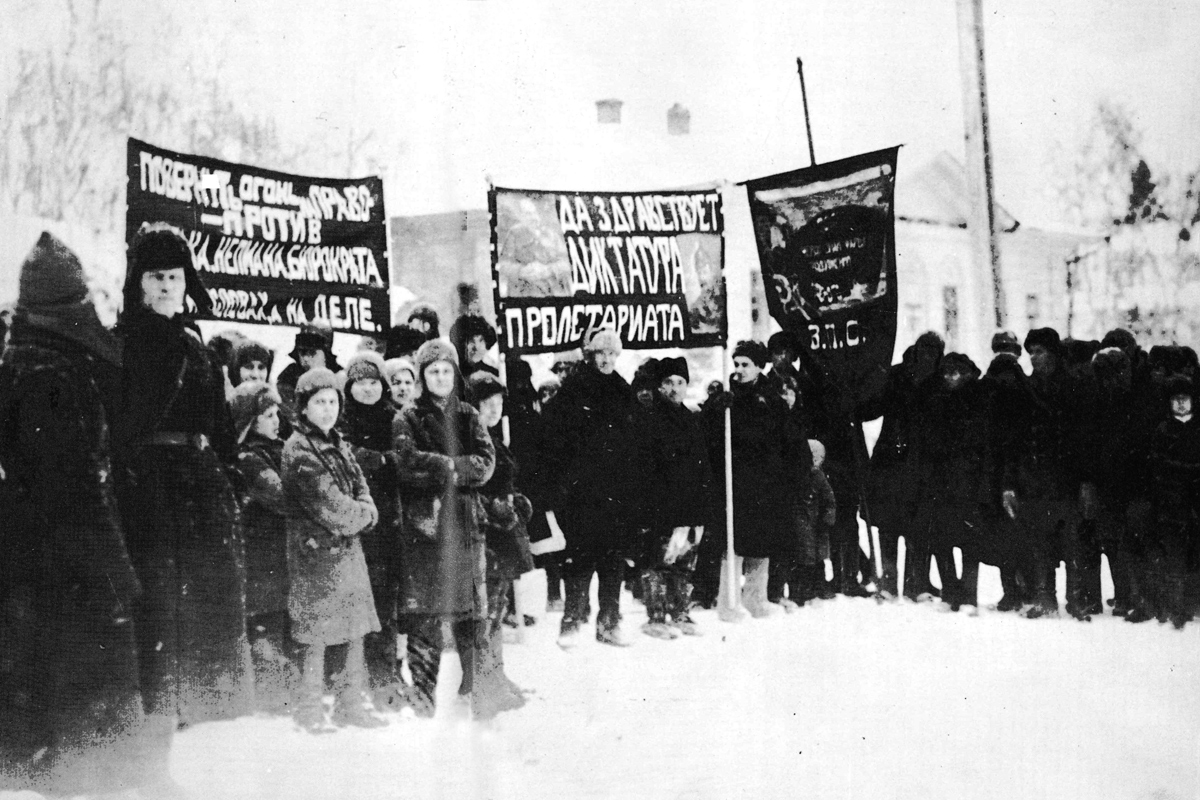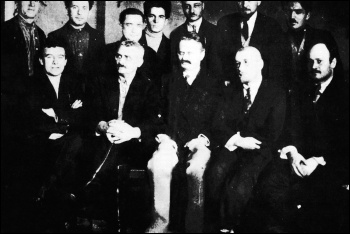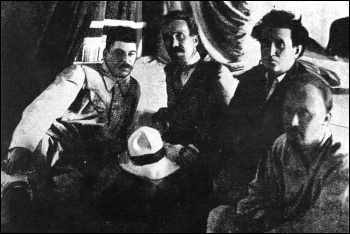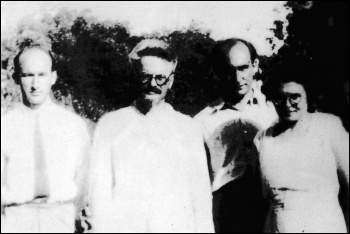90 years since Trotsky’s expulsion from Soviet Union
Leon Trotsky’s struggle against Stalinism
Lenny Shail, Socialist Party national committee
Ninety years ago this January, Leon Trotsky was exiled from the Soviet Union. Joseph Stalin and his increasingly powerful bureaucracy gave the command.
The motivation was not personal rivalry, but their need to wipe out the original ideas and methods of Bolshevism, the legacy of the 1917 October revolution, and any element of workers’ democracy within the Soviet Union.
Often it is asked: how could Trotsky, a key leader of the Bolshevik Party alongside Vladimir Lenin and the head of the Red Army, allow Stalin to rise and cement power around himself? Why did Trotsky not take power himself with the Red Army? How could he be ‘outmanoeuvred’ by Stalin?
Trotsky answered many of these questions himself, on the basis of his analysis of the political degeneration of the young workers’ state.
From a Marxist standpoint, it is completely superficial to present the conflict as a personal struggle between rival leaders. Stalin and Trotsky, in their different ways, personified conflicting social and political forces. Trotsky in a conscious way, Stalin unconsciously.
Trotsky opposed and organised against Stalin through political means. Stalin fought Trotsky and the ‘Left Opposition’ through state-sponsored terrorism.
“Stalin conducts a struggle on a totally different plane,” Trotsky wrote. “He seeks to strike not at the ideas of the opponent, but at his skull.”
Revolution isolated
Lenin and Trotsky had made clear from the start that the October 1917 Russian revolution could not survive indefinitely in isolation, especially in such an economically backward country. It had to be the spark for further revolutions across Europe and the world.
Even at the height of civil war and invasion by 21 imperialist armies, the Bolsheviks organised the first conference of the Communist (Third) International in 1919 to help organise Marxist revolutionary forces on an international basis.
Subsequent revolutions in Germany and Hungary failed, primarily because of the mistakes of inexperienced leaderships – and the lack of a party with the clear methods and ideas of the Bolsheviks.
Defeat in the German revolution in 1923 – which the blunders of Stalin and Nikolai Bukharin in the Third International’s leadership contributed to – reinforced the isolation of the young Soviet state.
Years of imperialist wars, followed by civil war to crush the revolution, had taken the lives of millions and caused severe privations. The civil war in particular cost the lives of many of those most courageous in defending the ideas of the revolution.
The mass of workers became exhausted. Seeing the failure of revolutions in larger, industrialised economies demoralised the masses still further.
In this crushing context of setback, isolation and low political activity, the crystallisation of a bureaucratic caste became possible. The bureaucracy formally defended the revolution, but increasingly it put its own comforts and privileges before the interests of the international revolution.
Like in any period of setback for the working class, even some revolutionaries turned away in despair from the genuine democratic and working-class methods of Marxism. They were joined by ambitious middle-class careerists, and malcontent, incompetent officials looking for promotion. This was Stalin’s base of power in the party.
In 1923, Lenin called for the removal of Stalin from the post of general secretary. He was aware of the dangers to the revolution and Stalin’s increasing work to bureaucratise the new state and the Bolshevik Party – by then called the Communist Party.
The Soviet Union was becoming “a workers’ state with bureaucratic deformations.” Lenin began preparing a struggle against the bureaucratisation of party and state. But his death in 1924 prevented him leading that struggle.
Left Opposition
With Lenin dead, Stalin began a systematic elimination of those fighting to defend workers’ democracy. In sync, the Third International increasingly became a tool of Russian foreign policy for the Stalinist bureaucracy.
There was an organised terror campaign against any remnant of the October revolution, over the course of two decades, until Trotsky was finally murdered by a Stalinist agent in Mexico in 1940.
But none of this happened without a struggle.
In 1923, Trotsky’s Left Opposition was established as a faction of the Communist Party. He proposed the ‘New Course’ in October: to campaign against bureaucratisation; for proven working-class elements to take leading positions in the party; for elections to all party positions; a plan for industrialisation; and policies to improve the lot of poorer peasants.
The bureaucracy feared the programme of the Left Opposition – for the restoration of workers’ democracy – would find the ear of new sections of workers. And it did. Thousands of workers supported it.
A struggle also erupted over Stalin’s so-called theory of ‘socialism in one country’. The Left Opposition continued to argue for genuine internationalism, and warned this policy would change the Third International into a counter-revolutionary tool of Stalin’s foreign policy.
The tragedy of the Spanish revolution, 1931-37, proved the warning correct. Eventually, in 1943, at the request of Tory prime minister Winston Churchill and US president Franklin Roosevelt, Stalin dissolved the Communist International.
Stalin’s direction and policies in the 1920s and 1930s resulted in disasters for the Soviet and international working class. The failed revolution in Germany in 1923, and subsequent mistakes, paving the way to fascism in 1933. The betrayal of the British general strike, when workers could have taken power, in 1926.
The bloody massacre of the Chinese revolution, 1925-27, at the hands of the capitalist and landlord Kuomintang party. Stalin had instructed Communists to join it, and allow Kuomintang forces to enter Shanghai in April 1927 – setting them up to be massacred at the hands of pro-capitalist military leader Chiang Kai-shek.
The list goes on. Many other struggles broke out with the Communist Party and Soviet state as Stalin manoeuvred against any possible opposition to his strengthened totalitarian regime.
Stalin’s purges
But by the end of 1927, the dominant Stalinist faction had decisively defeated the Left Opposition, imprisoning or exiling its leaders.
Members of the Left Opposition, followers of Lenin and Trotsky’s ideas, were arrested in their thousands and sent to labour camps in Siberia. Not only did they refuse to collaborate in any way, they continued their protests in the camps!
In October that year, on the tenth anniversary of the October revolution, Trotsky was forced out of the Kremlin and had to take refuge with oppositionist friends. Days later, he was expelled from the party.
Later, fellow oppositionist Adolph Joffe killed himself. It would be the first of many of Lenin and Trotsky’s allies and Left Oppositionists who were driven to death, or directly murdered, by Stalin’s regime.
A “river of blood” opened up between the genuine ideas, methods and workers’ democracy of the Bolsheviks and the October revolution, and the totalitarian methods, and systematic and ruthless repression of Stalinism.
In January 1928, Trotsky was forced into his last foreign exile – his first two had been under the Tsarist regime! First he was deported to Kazakhstan. Then in February 1929 he was deported to Turkey, on Prinkipo island, near Istanbul.
By then the struggle against Stalin had opened up internationally. Left Oppositionists in Europe and the Americas had been expelled from the Communist Parties and the Third International.
Some created small groups that proclaimed sympathy or solidarity with the Left Opposition. During this period, Trotsky worked on formulating the major programmatic statements of the International Left Opposition.
Fourth International
Rather than respond emotionally to his exile, and the continued degeneration of the Soviet Union, Trotsky set about the difficult task of assembling the forces of a new international revolutionary organisation. The Fourth International was founded in 1938, adopting as its core policy document Trotsky’s ‘Transitional Programme’.
Trotsky understood that the material gains of the 1917 revolution, and the nationalised planned economy that the bureaucracy rested on, still remained. In fact, they would allow the Soviet Union to continue to make some progress, and should be defended as part of a struggle to remove the Stalinist caste that had consolidated power at its top, in a political revolution for genuine workers’ democracy.
Trotsky warned that without democracy, the Soviet state would suffocate and continue its slow degeneration until it collapsed. A prognosis that proved true, decades later, when Stalinism fell in Russia and Eastern Europe and ruinous gangster capitalism took its place.
For Trotsky, the Third International presiding over the failure and destruction of the organisations of the German working class and allowing Adolf Hitler to take power signalled the Communist International and its leaders were no longer of any use to the working class around the world.
“An organisation which has not been wakened up by the thunderbolt of fascism… is dead and cannot be revived.”
The forces of the Left Opposition around the world set about building a new international based on the original and genuine methods of Marxism, Lenin and the October revolution.
Despite his central role in helping to lead the Russian working class to power, Trotsky was in no doubt of the historical issues at stake and his role while in exile. “I think the work in which I am engaged now, despite its extremely insufficient and fragmentary nature, is the most important work of my life…
“Now my work is the most ‘indispensable’ in the full sense of the word… To carry out the mission of arming a new generation with the revolutionary method.”
Debates around socialism, Trotskyism and Stalinism are once again opening up due to the inability of capitalism to provide a future for workers and young people. There are many essential lessons in the struggle of Leon Trotsky and the Left Opposition. The Socialist Party and Committee for a Workers’ International are proud to stand in that tradition today.
Further reading from leftbooks.co.uk
Short pamphlets
- ‘1917: The Year that Changed the World’ collection of articles from the Socialist
- ‘In Defence of October’ by Leon Trotsky
- ‘Stalinism and Bolshevism’ by Leon Trotsky (out of print – text available at socialistparty.org.uk)
More detailed books
- ‘History of the Russian Revolution’ by Leon Trotsky
- ‘The Revolution Betrayed’ by Leon Trotsky
- ‘The Transitional Programme’ by Leon Trotsky












